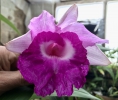|
|
|
|
| Register Yourself at Meyers Conservatory |
To register yourself with the Meyers Conservatory web site, please click the button
below and follow the instructions. You may just make a simple registration with your
email address and a password, but to use the advanced features like the Wish List
you should follow the registration process all the way into the User Information Page
where you can specify plants you are interested in and decide what kind of notifications
you will get.
|
|
|
|
|
| |
Established Seedlings of
Sobralia macrantha 'Bill' × self |
|
| |
|
|
| |
| Number: |
TN8575 |
| Name: |
Sobralia macrantha 'Bill' × self
|
| Type: |
self (What's that?) |
|
Seed Donor: |
Mr William Jasen
|
|
Click to Enlarge

Pod Parent Flower |
|
|
|
| |
For additional origin/habitat information supplied courtesy of
Charles and Margaret Baker, see further below, near the bottom of this page.
|
Temperatures we attempt to use in the lab & greenhouse:
| For Species: |
|
Spring, Summer, Autumn: days average 71°F, nights 55°F; best fit is Cool 70-52°F
(Source:
Baker's Web OSC) |
| For Species: |
|
Winter: days average 68°F, nights 49°F; best fit is Cool 70-52°F
(Source:
Baker's Web OSC) |
|
About the name...
| Etymology of |
macrantha |
|
From latinized Greek "macranthus" large-flowered.
(Source:
Mayr & Schmucker 1998) |
| Etymology of |
Sobralia |
|
Named for Dr. Francisco Sobral, Spanish botanist of the latter part of the 18th century.
(Source:
Pridgeon 1992) |
| Pronunciation of |
macrantha |
|
mak-RAN-tha
(Source:
Hawkes 1978) |
| Pronunciation of |
Sobralia |
|
so-BRAL-ee-ah
(Source:
Pridgeon 1992) |
|
If you would like to direct someone to this web page, please copy and paste this URL into your email:
http://troymeyers.com/d?128575
|
ESTABLISHED SEEDLINGS
of these are not currently available, but we have some maturing in the greenhouse and expect to offer them in the future.
There are 6 items with
1 plant per
item that will be considered for sale later.
Click here to see if we have flasks available.
|
|
|
| |
The origin/habitat information below is supplied courtesy of Charles and Margaret Baker
The following information is based on the name of the plant provided by the donor, and assumes that the name is correct. If the plant has been misidentified, then the following information may not be correct.
This text is copyrighted by the Bakers and may not be reproduced without permission.
ORIGIN/HABITAT: Mexico and Central America to Costa Rica. Throughout its
range, this orchid is found in a variety of habitats and microclimates.
Plants grow in leaf mold on calcareous rocks in forests, in tree crotches,
in fern roots covered by fallen leaves and other forest debris, in sandy
soil along stream banks, in wet soil in ravines, and on rocky canyon
walls. In Mexico, plants are found in the States of Chiapas, Oaxaca,
Puebla, and Veracruz as high as 10,850 ft. (3300 m). In Guatemala, plants
grow in the Departments of Alta Verapaz, Baja Verapaz, El Progreso,
Escuintla, Guatemala, Retalhuleu, San Marcos, Santa Rosa, Sololá,
Suchitepequez, and Zacapa at elevations up to 10,850 ft. (3300 m). In
Belize, plants grow in the Cayo district on well-drained slopes or on rock
outcroppings on open ridges at 150–3350 ft. (50–1020 m). In El Salvador,
plants are found at 5100–5900 ft. (1550–1800 m). In Honduras, this orchid
is usually found in the Caribbean watershed at 4350–7550 ft. (1320–2300
m). In Nicaragua, plants grow in numerous locations at 650–5750 ft.
(300–1745 m).
More about this information and the Bakers...
|
|
|
| |
|
|
|